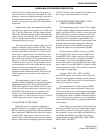
CIRCUIT DESCRIPTION
3-20
February 2001
Part No. 001-9800-001
Impedance matching between Q508 and Q509 is
provided by L501, several capacitors, and two sections
of microstrip (microstrip is described in the preceding
section). Resistor R523 lowers the Q of L501 to make
it less frequency selective. Q508 is powered by the
switched battery supply. AC signals are decoupled
from this supply by C517-C519 and ferrite bead
EP500.
Predriver Q509 is an RF power MOSFET. The
gate is biased at approximately one-half the drain
voltage by R519 and R522. Capacitors C512-C516,
C522, and C523 provide decoupling of AC signals.
R524 and R527 lower the Q of the input matching
circuit which improves stability.
Supply voltage to Q509 is from the power control
circuit described in Section 3.9.6. This circuit varies
the supply voltage to change the power output of Q509
in order to maintain constant transmitter power output.
RF choke L500, ferrite bead EP501, and several
capacitors isolate the power control circuit from RF
signals. Several capacitors and sections of microstrip
on the drain of Q509 provide an output impedance of
50 ohms to the power amplifier board. This stage
provides a gain of approximately 10 dB, resulting in a
power input to the PA board of up to approximately 8
watts.
3.9.3 DRIVER (Q600), FINAL (Q601)
Driver Q600 on the power amplifier board is used
with high power (40 watt) versions only. It is matched
to the 50 ohms by several capacitors and sections of
microstrip on the input. Class C self bias is provided
by L608 and ferrite bead EP603. From Q600 the signal
is fed to final amplifier Q601 which is similar in
design to Q600. Each stage has a gain of approxi-
mately 5 dB, resulting in an output power from Q601
of approximately 55 watts.
The supply voltage to these stages is the
unswitched battery supply. Therefore, power is
applied even when transceiver power is turned off.
Two RF chokes, a ferrite bead, and several capacitors
isolate this supply from RF signals. Current to final
amplifier Q601 flows through R600, and the power
control circuit monitors transmitter current by sensing
the voltage drop across it.
3.9.4 ANTENNA SWITCH
The antenna switch circuit consists of Q602,
CR601, CR603, several other components, and also a
section of microstrip and CR200 on the RF board. This
circuit switches the antenna to the receiver in the
receive mode and the transmitter in the transmit mode.
Switching transistor Q602 is controlled by the
transmit signal from the Q7 output (pin 11) of shift
register U807. This is the same signal that controls
transmit 8-volt supply switch Q506/Q507. This signal
is high in the transmit mode and low in the receive
mode. Therefore, Q602 turns on in the transmit mode
and current flows from the collector of final amplifier
Q601 through L601, CR601/R602, L606, R608/
CR603, R609, and R610.
Diodes CR601 and CR603 are PIN diodes like
those in the receiver front end (see Section 3.8.1).
When a PIN diode is forward biased, it presents a very
low impedance. Therefore, the transmit signal has a
low-impedance path through CR601 to the directional
coupler and C614. With CR603 also forward biased, it
effectively connects L606 to AC ground through
C652. A parallel resonant circuit is then formed by
L606 and C643 which presents a high impedance into
the receiver for the transmit signal.
Further receiver isolation in the transmit mode is
provided by a grounded quarter-wave line. This
quarter-wave line is formed by the section of micro-
strip connected to C650/C651 and another section on
the RF board. The receiver end of this quarter-wave
line is AC grounded by PIN diode CR200 on the RF
board. This diode is forward biased in the transmit
mode by the 8-volt transmit supply applied through
R200. When one end of a quarter-wave line is
grounded, the other end presents a high impedance to
the quarter-wave frequency (the transmit frequency
band in this case). C650 and C651 on the PA board
provide impedance matching.
In the receive mode, all three PIN diodes are
reverse biased. Therefore, CR601 presents a high
impedance into the transmitter for the receive signal,
L606 presents a low impedance because it is no longer
resonant, and the quarter-wave line presents a low
impedance because it is no longer grounded by
CR200.
UHF TRANSMITTER DESCRIPTION


















